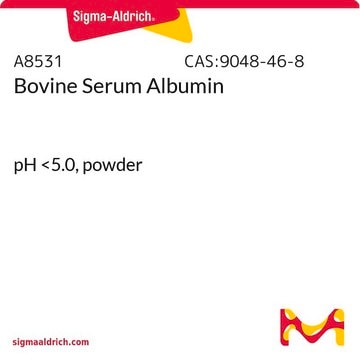1.15444
Coomassie Brilliant blue G 250 (C.I. 42655)
for electrophoresis
Synonym(e):
Coomassie Brilliant blue G 250 (C.I. 42655), Acid blue 90, Brilliant Blue G, Cyanine G, Polar Blue G, SERVA BLUE G, protein gel stain
About This Item
Empfohlene Produkte
Qualitätsniveau
Wirksamkeit
>5000 mg/kg LD50, oral (Rat)
Methode(n)
protein staining: suitable
pH-Wert
6.4 (20 °C, 10 g/L in H2O)
Löslichkeit
40 g/L
Schüttdichte
520 kg/m3
Lagertemp.
no temp limit
InChI
1S/C47H49N3O7S2.Na/c1-6-49(31-35-11-9-13-43(29-35)58(51,52)53)40-21-25-45(33(4)27-40)47(37-15-17-38(18-16-37)48-39-19-23-42(24-20-39)57-8-3)46-26-22-41(28-34(46)5)50(7-2)32-36-12-10-14-44(30-36)59(54,55)56;/h9-30,48H,6-8,31-32H2,1-5H3,(H-,51,52,53,54,55,56);/q;+1/p-1
InChIKey
CMGWKYXJIYYESN-UHFFFAOYSA-M
Allgemeine Beschreibung
Anwendung
Hinweis zur Analyse
Absorptionsmaximum λmax. (Puffer pH 7.0): 577 - 584 nm
Spez. Extinktion E1%/1cm (λmax; 0.01 g/l; Puffer pH 7.0; berechnet auf getrocknete Substanz): 450 - 570
DC-Prüfung: entspricht
Trocknungsverlust (110 °C): ≤ 8 %
Eignung für die Elektrophorese: entspricht
Rechtliche Hinweise
Lagerklassenschlüssel
11 - Combustible Solids
WGK
WGK 3
Flammpunkt (°F)
Not applicable
Flammpunkt (°C)
Not applicable
Analysenzertifikate (COA)
Suchen Sie nach Analysenzertifikate (COA), indem Sie die Lot-/Chargennummer des Produkts eingeben. Lot- und Chargennummern sind auf dem Produktetikett hinter den Wörtern ‘Lot’ oder ‘Batch’ (Lot oder Charge) zu finden.
Besitzen Sie dieses Produkt bereits?
In der Dokumentenbibliothek finden Sie die Dokumentation zu den Produkten, die Sie kürzlich erworben haben.
Kunden haben sich ebenfalls angesehen
Artikel
Mögliche Ursachen und Abhilfemaßnahmen für Probleme, die bei der Vorbereitung von Proben für SDS-PAGE (Natriumdodecylsulfat-Polyacrylamid-Gelelektrophorese) auftreten, und Optimierung der Elektrophoresebedingungen.
Identify causes and remedies for SDS-PAGE sample preparation challenges and optimize electrophoresis conditions.
Unser Team von Wissenschaftlern verfügt über Erfahrung in allen Forschungsbereichen einschließlich Life Science, Materialwissenschaften, chemischer Synthese, Chromatographie, Analytik und vielen mehr..
Setzen Sie sich mit dem technischen Dienst in Verbindung.







